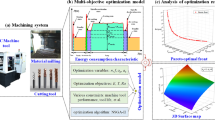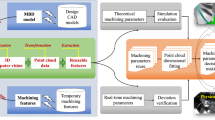Abstract
The ruled surface is an important modeling method of the product. With high-performance requirement, more and more complex ruled surfaces with the characteristic of variant curvature are used in auto, aviation, or die mold. The time-varying tool position and orientation make the prediction of surface topography very difficult in the five-axis machine tool processing. In this paper, a three-dimensional surface topography prediction method is proposed. The point cloud of cutting edge is obtained after a series of matrix transformation by calculating the instant information of the local tool coordinate. Then, lots of tiny bounding boxes are constructed based on the profile of the workpiece. The 3D surface topography is obtained by the Boolean operation between the enveloping body of cutting edge and the tiny bounding boxes. The geometric error of the machine tool, the vibrations, and the deformation of the tool is also considered in the generation of the surface topography. The presented method is validated by a case study of the S test piece. The prediction results are verified by the measuring experiment at the same time. Finally, a partition optimization method on the surface topography for the complex surface of the S test piece is presented. The dynamic modification of the cutting parameters in different partitions of the milling process can greatly improve the surface quality without reducing efficiency.
























Similar content being viewed by others
References
Xie D, Ding J, Liu F, Jiang Z, Du L, Wang W, Song Z (2014) Modeling errors forming abnormal tool marks on a twisted ruled surface in flank milling of the five-axis CNC. J Mech Sci Technol 28(11):4717–4726
Lin RS, Koren Y (2000) Ruled surface machining on five-axis CNC machine tools. J Manuf Process 2(1):25–35
Olvera D, Calleja A, Lacalle LNLD, Campa F, Lamikiz A (2012) Flank milling of complex surfaces - machining of complex sculptured surfaces. Springer, London, pp 1–31
Gao T, Zhang W, Qiu K, Wan M (2006) Numerical simulation of machined surface topography and roughness in milling process. J Manuf Sci Eng 128(1):96–103
Buj-Corral I, Vivancos-Calvet J (2011) Influence of feed, eccentricity and helix angle on topography obtained in side milling processes. Int J Mach Tools Manuf 51(12):889–897
Wang Z, Wang B, Yuan J (2019) Modeling of surface topography based on cutting vibration in ball-end milling of thin-walled parts. Int J Adv Manuf Technol 101(5–8):1837–1854
Li S, Dong Y, Li Y, Li P, Yang Z, Landers RG (2019) Geometrical simulation and analysis of ball-end milling surface topography. Int J Adv Manuf Technol 102(5–8):1885–1900
Arizmendi M, Fernández J, Gil A, Veiga F (2009) Effect of tool setting error on the topography of surfaces machined by peripheral milling. Int J Mach Tools Manuf 49(1):36–52
Arizmendi M, Campa FJ, Fernández, de Lacalle LL, Gil A, Bilbao E, Lamikiz A (2012) Model for surface topography prediction in peripheral milling considering tool vibration. Cirp Ann-Manuf Tech 58(1):93–96
Jiang H, Long X, Meng G (2008) Study of the correlation between surface generation and cutting vibrations in peripheral milling. J Mater Process Technol 208(1–3):229–238
Costes JP, Moreau V (2011) Surface roughness prediction in milling based on tool displacements. J Manuf Process 13(2):133–140
Wojciechowski S (2011) Machined surface roughness including cutter displacements in milling of hardened steel. Metrol Meas Syst 18(3):429–440
Surmann T, Biermann D (2008) The effect of tool vibrations on the flank surface created by peripheral milling. CIRP Ann - Manuf Tech 57(1):375–378
Arizmendi M, Campa FJ, Fernández J, de Lacalle LL, Gil A, Bilbao E, Lamikiz A (2009) Model for surface topography prediction in peripheral milling considering tool vibration. CIRP Ann - Manuf Tech 58(1):93–96
Zhang C, Zhang H, Li Y, Zhou L (2015) Modeling and on-line simulation of surface topography considering tool wear in multi-axis milling process. Int J Adv Manuf Technol 77(1–4):735–749
Pimenov DY, Guzeev VI, Krolczyk G, Mia M, Wojciechowski S (2018) Modeling flatness deviation in face milling considering angular movement of the machine tool system components and tool flank wear. Precis Eng 54:327–337
Yang D, Liu Z (2015) Surface plastic deformation and surface topography prediction in peripheral milling with variable pitch end mill. Int J Mach Tools Manuf 91:43–53
Denkena B, Köhler J, Sellmeier V, Mörke T (2011) Topography prediction of resilient parts after flank milling with chamfered tools. Prod Eng Res Devel 5(3):273–281
Omar OEEK, El-Wardany T, Ng E, Elbestawi MA (2007) An improved cutting force and surface topography prediction model in end milling. Int J Mach Tools Manuf 47(7–8):1263–1275
Wojciechowski S, Matuszak M, Powałka B, Madajewski M, Maruda RW, Królczyk GM (2019) Prediction of cutting forces during micro end milling considering chip thickness accumulation. Int J Mach Tools Manuf 147:103466
Li M, Huang J, Liu X, Wang J, Jia L (2018) Research on surface morphology of the ruled surface in five-axis flank milling. Int J Adv Manuf Technol 94(5–8):1–10
Hao W, Wan X J (2009) Prediction surface topography in flank milling. International Conference on Intelligent Robotics and Applications, Berlin, Heidelberg, December 2009, 5928:967–975
Urbikain G, Lacalle LNLD (2018) Modelling of surface roughness in inclined milling operations with circle-segment end mills. Simul Model Pract Th 84:161–176
Zhang X, Pan X, Wang G (2019) Influence factors of surface topography in micro-side milling. Int J Adv Manuf Technol 105(12):5239–5245
Zhang X, Zhang J, Pang B, Zhao W (2016) An accurate prediction method of cutting forces in 5-axis flank milling of sculptured surface. Int J Mach Tools Manuf 104:26–36
Yildiz AR (2013) A new hybrid differential evolution algorithm for the selection of optimal machining parameters in milling operations. Appl Soft Comput 13(3):1561–1566
Yildiz AR (2013) Cuckoo search algorithm for the selection of optimal machining parameters in milling operations. Int J Adv Manuf Technol 64(1–4):55–61
Subramanian M, Sakthivel M, Sooryaprakash K, Sudhakaran R (2013) Optimization of cutting parameters for cutting force in shoulder milling of Al7075-T6 using response surface methodology and genetic algorithm. Procedia Eng 64(12):690–700
Song Z, Wang L, Tao W, Wang W (2018) The mechanism of curvature for complex surfaces during five-axis flank milling. Int J Adv Manuf Technol 94:1665–1676
Wang W, Jiang Z, Tao W, Zhuang W (2015) A new test part to identify performance of five-axis machine tool-part I. Int J Adv Manuf Technol 79:729–738
Eberhart R, Kennedy J (1995) Particle swarm optimization. In Proceedings of the IEEE international conference on neural networks 4:1942–1948
Funding
TThe authors would like to thank the Major Project of National Science and Technology (No. 2017ZX04002001), the Fundamental Research Funds for the Central Universities (ZYGX2019J032), NSAF (U1830110) and foundation of key laboratory of ultra-precision machining technology in Chinese academy of engineering physics (K1126-17-Y).
Author information
Authors and Affiliations
Corresponding author
Additional information
Publisher’s note
Springer Nature remains neutral with regard to jurisdictional claims in published maps and institutional affiliations.
Rights and permissions
About this article
Cite this article
Wang, W., Li, Q. & Jiang, Y. A novel 3D surface topography prediction algorithm for complex ruled surface milling and partition process optimization. Int J Adv Manuf Technol 107, 3817–3831 (2020). https://doi.org/10.1007/s00170-020-05263-4
Received:
Accepted:
Published:
Issue Date:
DOI: https://doi.org/10.1007/s00170-020-05263-4




